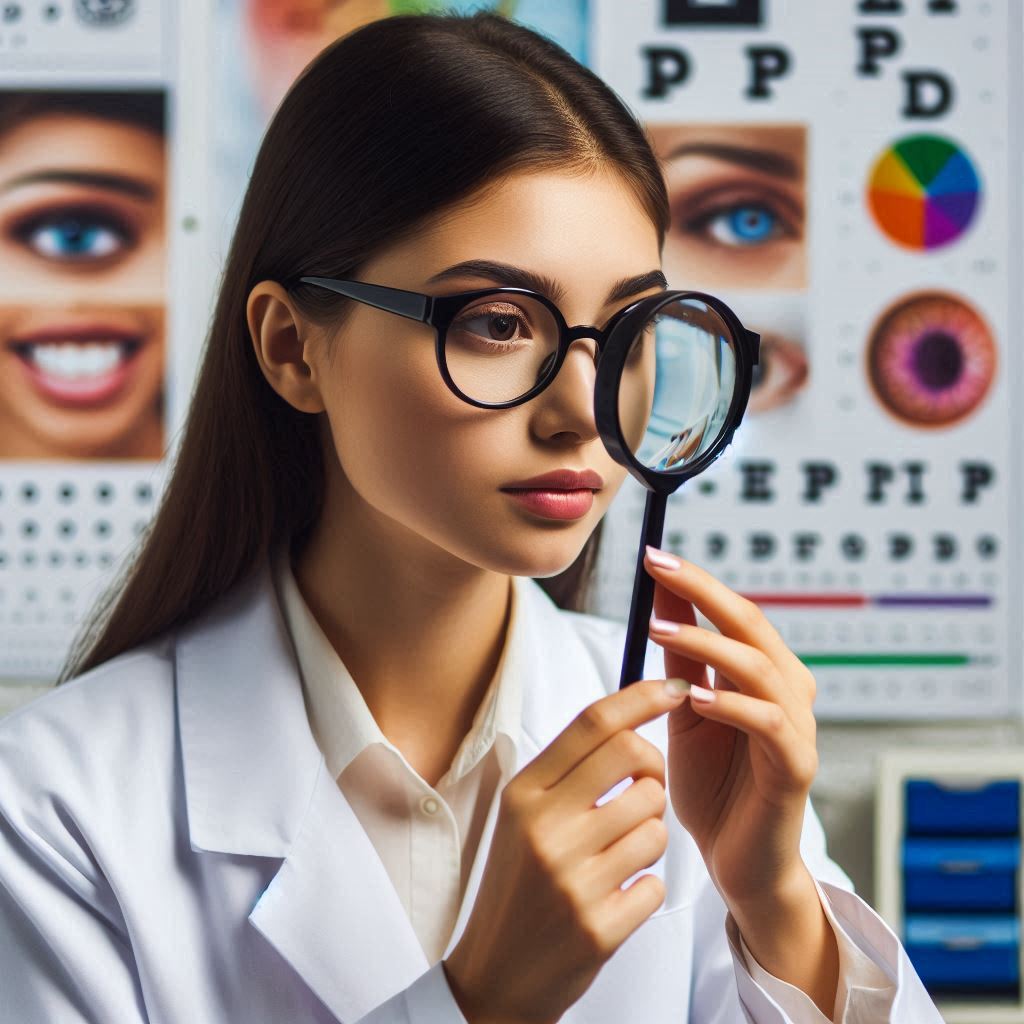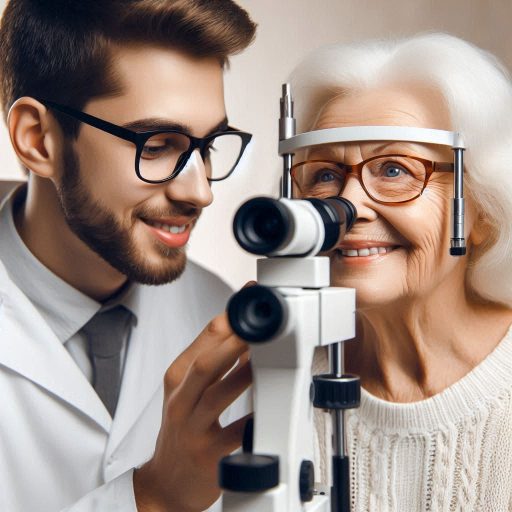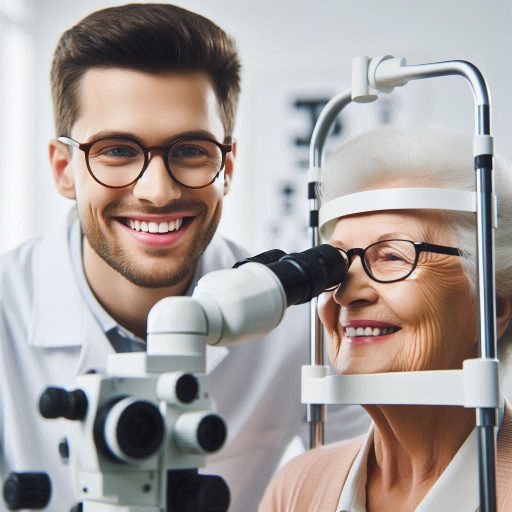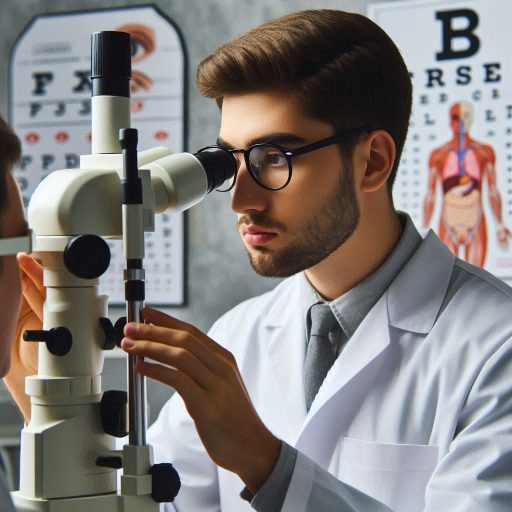Introduction
Misconceptions about optometry and eye care are widespread and can lead to confusion.
Many people underestimate the importance of regular eye exams and preventive care.
They may believe that vision problems only affect older adults or that optometrists only prescribe glasses.
These misconceptions can negatively impact individuals’ eye health.
Debunking these myths is crucial for better understanding and awareness.
When people recognize the full scope of optometry, they are more likely to seek appropriate care.
Understanding that eye exams can detect systemic diseases, such as diabetes or hypertension, encourages more frequent visits.
It’s essential to educate the public about the role of optometrists in diagnosing and managing various eye conditions.
Additionally, clearing up misconceptions can help patients make informed decisions about their eye care.
Many individuals may avoid necessary treatments due to misunderstandings about the optometry field.
By promoting accurate information, optometrists can enhance patient trust and encourage proactive eye health management.
We will provide facts to counter these myths and highlight the importance of regular eye examinations.
Increasing awareness can lead to improved eye health outcomes and a better understanding of optometry’s vital role.
Misconception: Optometrists are the same as ophthalmologists
Key Differences Between Optometrists and Ophthalmologists
Many people often confuse optometrists with ophthalmologists.
Understanding the differences between these two professions is essential for comprehensive eye care.
Optometrists hold a Doctor of Optometry (OD) degree.
They complete four years of optometry school after obtaining an undergraduate degree.
Their training focuses on vision science, eye health, and visual disorders.
Ophthalmologists, on the other hand, are medical doctors (MDs) or doctors of osteopathic medicine (DOs).
They complete medical school and then undergo residency training in ophthalmology.
This training typically lasts four years and includes surgery and medical management of eye conditions.
The scope of practice also differs between the two professions.
Optometrists primarily provide primary eye care, including vision tests and corrective lens prescriptions.
They can also diagnose and manage common eye conditions like dry eye and allergies.
Some optometrists can perform minor surgical procedures, such as foreign body removal.
In contrast, ophthalmologists perform surgical interventions and complex medical treatments.
They can manage severe eye diseases, such as glaucoma and cataracts.
Additionally, ophthalmologists often specialize in specific areas, such as retina, cornea, or pediatric eye care.
Importance of Visiting Both Professionals for Comprehensive Eye Care
Visiting both optometrists and ophthalmologists ensures comprehensive eye care.
Optometrists serve as the first line of defense in eye health.
They conduct routine eye exams and screen for vision problems.
Regular visits to an optometrist can help identify potential issues early on.
If an optometrist detects a more severe condition, they will refer the patient to an ophthalmologist.
This referral allows for specialized care and treatment.
Patients with chronic conditions or those requiring surgery benefit greatly from the expertise of an ophthalmologist.
Both professionals work collaboratively to provide the best care possible.
Optometrists can manage ongoing eye care needs, while ophthalmologists address complex issues.
This teamwork creates a holistic approach to eye health.
Educating patients about the roles of both optometrists and ophthalmologists is essential.
Many individuals may not realize the importance of seeing both types of professionals.
Regular eye exams with optometrists can help maintain overall vision health.
It is vital for patients to understand that eye care is not one-size-fits-all.
Each profession offers unique expertise that complements the other.
Encouraging patients to establish a relationship with both optometrists and ophthalmologists will benefit their eye health.
Understanding the key differences between optometrists and ophthalmologists is crucial for informed eye care decisions.
Optometrists focus on primary eye care and vision correction, while ophthalmologists provide surgical and medical treatments.
Both professionals play vital roles in ensuring comprehensive eye health.
By visiting both optometrists and ophthalmologists, patients can receive the best possible care for their unique needs.
This collaborative approach enhances overall eye health and ensures timely intervention for any eye conditions.
Read: Profiles in Success: Leading Chemists of the 21st Century in the US
Misconception: Eye exams are only necessary if you have poor vision
The Importance of Regular Eye Exams
Many people believe that only those with vision problems need eye exams.
This misconception can lead to serious consequences for eye health.
Regular eye exams are essential for everyone, even those with perfect vision.
They can help detect early signs of eye diseases and conditions.
Eye diseases often develop without noticeable symptoms.
Conditions like glaucoma and macular degeneration may not show signs until significant damage occurs.
Early detection through routine eye exams can prevent irreversible vision loss.
Optometrists can identify risk factors and monitor changes in eye health over time.
Additionally, eye exams evaluate overall health beyond vision.
They can reveal underlying health issues, such as diabetes or high blood pressure.
During an eye exam, optometrists assess not only visual acuity but also the health of the entire eye.
This comprehensive approach ensures that any potential problems are addressed promptly.
Early Detection of Eye Diseases
Early detection is crucial for effective treatment and management of eye diseases.
Many conditions respond better to treatment when diagnosed in their initial stages.
For example, if glaucoma is detected early, medication can help control intraocular pressure.
This intervention can prevent significant vision loss and preserve eye health.
Regular eye exams also allow optometrists to monitor existing conditions.
Patients with diabetes, for instance, require ongoing eye care to prevent diabetic retinopathy.
Routine examinations can help track the progression of the disease.
This monitoring enables timely interventions to protect vision.
Furthermore, pediatric patients benefit greatly from early eye exams.
Children may not recognize or communicate vision problems.
Comprehensive eye exams can identify issues like amblyopia (lazy eye) or refractive errors.
Addressing these problems early can enhance a child’s visual development.
Preventing Vision Loss and Maintaining Eye Health
Preventing vision loss should be a priority for everyone.
Regular eye exams play a vital role in maintaining overall eye health.
They allow optometrists to establish a baseline for each patient’s eye health.
Tracking changes over time helps identify emerging issues.
In addition to disease detection, eye exams also provide opportunities for education.
Optometrists can offer personalized advice on eye care and protective measures.
Patients can learn about the importance of UV protection, proper lighting, and screen time management.
This education empowers patients to make informed choices about their eye health.
Moreover, routine exams often include discussions about lifestyle factors.
Nutrition and exercise significantly impact eye health.
By promoting healthy habits, optometrists can help patients maintain optimal vision.
Regular eye exams are essential for everyone, regardless of their vision status.
They play a critical role in detecting early signs of eye diseases.
Moreover, these exams can help prevent vision loss and maintain overall eye health.
By dispelling misconceptions about eye care, we can encourage more people to prioritize their eye health.
Ultimately, proactive eye care ensures a lifetime of healthy vision for all individuals.
Taking the time for routine eye exams can lead to better outcomes and a higher quality of life.
Read: The Life and Times of a U.S. Physicist: A Day in Detail
Misconception: Contact lenses are harmful to the eyes
Myths Surrounding Contact Lenses
Many people hold misconceptions about contact lenses, often believing they are uncomfortable.
While some initial discomfort may occur, most lenses are designed for comfort.
Advances in technology have led to softer, more breathable materials.
Many users adapt quickly and find contact lenses comfortable for daily wear.
Another common myth is that contact lenses cause eye infections.
In reality, infections typically result from improper use or care, not the lenses themselves.
When worn and maintained correctly, contact lenses can be safe and effective.
Educating patients about proper hygiene can significantly reduce the risk of infections.
Many individuals also believe that contact lenses can damage their eyes.
While there is a small risk, responsible use minimizes this danger.
Issues arise mainly from neglecting proper care and wearing schedules.
Optometrists emphasize that regular check-ups can help monitor eye health and address any concerns.
Proper Use and Care of Contact Lenses
To ensure eye safety, understanding the proper use and care of contact lenses is crucial.
First, always wash your hands before handling lenses.
Use soap and water to eliminate any bacteria and dirt.
Dry your hands with a lint-free towel to avoid transferring particles to your eyes.
Next, follow the instructions provided by your eye care professional.
Different types of lenses have unique care requirements.
Some are daily disposables, while others can be worn for extended periods.
Adhering to the recommended schedule helps maintain eye health.
Additionally, use the appropriate cleaning solutions for your lenses.
Never use water or saliva to clean lenses, as these can introduce harmful bacteria.
Always store your lenses in fresh solution and replace the case regularly.
Cleaning and replacing your lens case can significantly reduce infection risk.
Also, avoid wearing contact lenses while swimming or in hot tubs.
Water can introduce bacteria and increase the risk of infection.
If you must wear lenses during these activities, consider using prescription goggles instead.
Remember to give your eyes regular breaks from contact lenses.
Wearing them for extended periods can lead to dryness and discomfort.
Following the recommended wear time helps maintain comfort and eye health.
Finally, schedule regular eye exams to monitor your eye health.
Your optometrist can assess your lenses’ fit and provide necessary updates.
Regular check-ups ensure that you address any potential issues before they become serious.
Many misconceptions surround contact lenses, from comfort to safety.
Addressing these myths is essential for encouraging proper use.
By educating patients about the correct handling and care of contact lenses, optometrists can promote eye safety.
With the right information, patients can enjoy the benefits of contact lenses while keeping their eyes healthy.
Read: Salary Ranges: What to Expect as a Physicist in the USA

Misconception: Eye exercises can improve vision
Limitations of Eye Exercises for Improving Vision
Many people believe that eye exercises can significantly improve vision.
While these exercises can help relieve eye strain, they have limitations.
Eye exercises cannot correct serious eye conditions like myopia, hyperopia, or astigmatism.
These conditions result from the shape of the eye, not from muscle strength.
Myopia, or nearsightedness, occurs when the eye is too long.
Hyperopia, or farsightedness, happens when the eye is too short.
Astigmatism results from an irregularly shaped cornea.
Eye exercises cannot change these physical characteristics.
Therefore, relying solely on exercises can lead to frustration and poor vision.
Additionally, scientific evidence supporting the effectiveness of eye exercises is limited.
Most research suggests that these exercises do not produce significant improvements in vision.
While they may help with focus and relaxation, they cannot replace proper corrective measures.
Effective Ways to Maintain Good Vision
To maintain good vision, optometrists recommend several effective strategies.
The first is wearing corrective lenses, such as glasses or contact lenses.
These lenses can compensate for refractive errors and provide clear vision.
Regular eye exams are crucial for updating prescriptions and ensuring optimal eye health.
Another essential strategy is adopting a healthy diet.
Foods rich in vitamins A, C, and E can support eye health.
Leafy greens, carrots, and fish are particularly beneficial.
Omega-3 fatty acids found in fish help protect against age-related macular degeneration.
Staying hydrated also plays a vital role in maintaining good vision.
Proper hydration keeps the eyes moist and reduces the risk of dry eyes.
Drinking plenty of water throughout the day supports overall health, including eye health.
Practicing proper eye hygiene is crucial for preventing eye problems.
Wash your hands regularly, especially before touching your eyes.
Avoid rubbing your eyes, as this can introduce bacteria and lead to infections.
Moreover, take regular breaks from screens to reduce eye strain.
Follow the 20-20-20 rule: every 20 minutes, look at something 20 feet away for 20 seconds.
This practice helps relax the eye muscles and prevent fatigue.
Additionally, protecting your eyes from harmful UV rays is essential.
Wear sunglasses with UV protection when outdoors.
This measure helps prevent cataracts and other eye conditions associated with sun exposure.
In essence, while eye exercises may offer some benefits, they have limitations, especially for serious eye conditions.
Myopia, hyperopia, and astigmatism require corrective lenses for effective treatment.
To maintain good vision, optometrists recommend wearing corrective lenses, eating a healthy diet, and practicing proper eye hygiene.
Incorporating these strategies into your daily routine can significantly impact your eye health.
By understanding the facts about vision improvement, you can make informed decisions about your eye care.
Read: Physics Specializations: Choosing Your Path in the U.S.
Misconception: Sunglasses are only necessary in the summer
The Importance of Wearing Sunglasses Year-Round
Many people believe sunglasses are only necessary during summer.
This misconception can lead to serious eye damage throughout the year.
Harmful UV rays can penetrate clouds and cause long-term damage, regardless of the season.
Protecting your eyes should be a year-round commitment.
Exposure to UV rays increases the risk of cataracts, macular degeneration, and other eye conditions.
Chronic UV exposure can harm the cornea and cause photokeratitis, a painful condition similar to sunburn.
Wearing sunglasses reduces the amount of UV radiation that reaches your eyes.
It is essential for maintaining overall eye health.
In winter, UV rays can reflect off snow, intensifying exposure.
Even on cloudy days, UV rays can still cause harm.
Therefore, wearing sunglasses should be part of your daily routine, no matter the weather.
By prioritizing eye protection, you can significantly reduce your risk of developing serious eye issues in the future.
Tips for Choosing the Right Sunglasses with UV Protection
Selecting the right sunglasses is crucial for optimal eye care.
Look for sunglasses that block 100% of UVA and UVB rays.
Labels stating “100% UV protection” or “UV400” guarantee full coverage.
These features ensure that harmful rays do not penetrate your sunglasses.
Consider the lens color when choosing sunglasses.
While darker lenses may seem better, they don’t always provide more protection.
The critical factor is UV protection, not lens darkness.
Gray lenses reduce brightness without distorting colors.
Brown and amber lenses enhance contrast, making them suitable for various activities.
The frame style also plays a role in protecting your eyes.
Wraparound sunglasses provide additional coverage, blocking light from entering from the sides.
This style reduces glare and enhances peripheral vision.
Polarized lenses can minimize glare from reflective surfaces, making them ideal for outdoor activities.
Ensure that the sunglasses fit well.
Ill-fitting sunglasses can allow UV rays to enter around the edges.
Opt for models that sit snugly on your face without pinching or slipping.
Adjustable nose pads and temple arms can help achieve a secure fit.
Additionally, consider sunglasses designed for specific activities.
Sports sunglasses often feature durable materials and additional safety features.
They can provide better protection during outdoor activities, such as biking or running.
Wearing sunglasses year-round is vital for protecting your eyes from harmful UV rays.
Many misconceptions surround the need for sunglasses, but understanding the facts can enhance eye care.
Choose sunglasses that provide 100% UV protection, regardless of lens color or darkness.
Additionally, focus on proper fit and frame style for maximum coverage.
By prioritizing eye protection with quality sunglasses, you can significantly reduce the risk of eye damage and maintain long-term eye health.
Misconception: Children do not need eye exams until they start school
The Importance of Pediatric Eye Exams
Pediatric eye exams are essential for children’s overall health and development.
Parents often underestimate the significance of early vision screenings.
Starting eye exams in infancy allows optometrists to detect potential issues early.
The American Optometric Association recommends that children have their first eye exam at six months of age.
During these early exams, optometrists can identify common vision problems.
Conditions such as strabismus (crossed eyes) or amblyopia (lazy eye) can be treated effectively when caught early.
Early detection increases the chances of successful treatment, which can prevent long-term vision issues.
Many parents believe that children will mention any vision problems they experience.
However, young children may not recognize or communicate their vision difficulties.
Regular eye exams help ensure that potential problems are identified, even if children do not report them.
The Impact of Undiagnosed Vision Issues on Learning
Undiagnosed vision issues can significantly impact a child’s learning and development.
Vision problems can hinder a child’s ability to read and understand written material.
Difficulties in seeing the board in school can lead to frustration and disengagement.
Children with uncorrected vision problems may struggle academically.
They might exhibit signs of trouble concentrating or following lessons.
This can lead to poor grades and a lack of confidence in their abilities.
Research indicates that children with vision issues are at a higher risk for learning disabilities.
Moreover, vision problems can affect social interactions.
Children may avoid activities that require good vision, leading to isolation.
This avoidance can result in missed opportunities for social development and relationship-building.
Parents should also recognize the link between vision and behavior.
Children with undiagnosed vision problems may act out in frustration.
They might appear distracted or uninterested in tasks that require visual attention.
Promoting Awareness and Early Intervention
Promoting awareness about the importance of pediatric eye exams is crucial.
Educating parents about the benefits of regular eye check-ups can make a difference.
Many parents may not be aware of the critical role that vision plays in learning and development.
Encourage parents to schedule eye exams for their children as part of routine health care.
Remind them that early intervention can lead to better outcomes.
Children who receive proper treatment for vision problems are more likely to thrive academically and socially.
Optometrists should actively communicate the importance of these exams during routine visits.
By providing information and resources, they can empower parents to take action.
Creating partnerships with schools can also help spread awareness about the significance of eye health.
Pediatric eye exams are vital for detecting and treating vision problems early.
Undiagnosed vision issues can significantly hinder a child’s learning and development.
By stressing the importance of regular eye exams, we can help ensure children reach their full potential.
Early intervention is key to supporting children’s academic success and overall well-being.
Misconception: Reading in dim light can damage your eyes
Debunking the Myth: Reading in Dim Light
Many people believe that reading in dim light causes permanent eye damage.
This misconception has persisted for generations.
However, research shows that while dim lighting may not harm your eyes, it can lead to temporary discomfort.
Reading in low light can cause eye strain, headaches, and fatigue.
When your eyes struggle to focus, you may experience symptoms like dryness or irritation.
These effects are usually temporary and resolve when you switch to brighter lighting.
Understanding this can help alleviate unnecessary worries about long-term damage.
Transform Your Career Today
Unlock a personalized career strategy that drives real results. Get tailored advice and a roadmap designed just for you.
Start NowTips for Proper Lighting
Proper lighting is essential for comfortable reading.
Start by choosing well-lit areas for reading or studying.
Natural light is often the best option.
Position yourself near windows to take advantage of daylight.
If natural light is insufficient, consider using adjustable lamps.
Select lamps with adjustable brightness settings.
This allows you to find the ideal level of light for your needs.
Bright light can help reduce eye strain during activities like reading or using screens.
Additionally, ensure that your light source is not directly behind you.
This can create glare on the pages and make reading difficult.
Instead, position the light over your shoulder, casting light onto the reading material.
Consider using light bulbs that mimic natural daylight.
These bulbs provide a more comfortable reading experience.
They reduce harsh shadows and promote better visibility.
Investing in high-quality lighting can significantly enhance your eye comfort.
Reading Habits to Protect Eye Health
In addition to proper lighting, your reading habits play a crucial role in eye health.
Take regular breaks to reduce eye strain.
Use the 20-20-20 rule: every 20 minutes, look at something 20 feet away for 20 seconds.
This simple practice can help relax your eye muscles.
Adjust your reading distance to ensure comfort.
Hold books or screens at least 16 to 18 inches away from your eyes.
This distance allows for optimal focus and reduces strain on your eyes.
Maintain a comfortable reading posture as well.
Sit in a supportive chair with good back support.
Ensure your reading material is at eye level to prevent awkward neck and shoulder positions.
Stay hydrated to keep your eyes moist.
Drink plenty of water throughout the day to avoid dryness.
Additionally, consider using artificial tears if you experience dryness or irritation during prolonged reading.
Lastly, schedule regular eye exams with your optometrist.
They can help monitor your eye health and recommend appropriate measures to reduce strain.
Early detection of potential issues can lead to better long-term outcomes.
To sum it up, reading in dim light does not cause permanent eye damage, but it can lead to discomfort.
Understanding this misconception helps reduce anxiety about eye health.
By implementing proper lighting and adopting healthy reading habits, you can protect your eyes.
Follow the tips provided to create a comfortable reading environment.
Prioritize your eye health to ensure a lifetime of clear vision and comfort.
Conclusion
Common misconceptions about optometry and eye care can lead to poor health decisions.
Many people believe that optometrists only prescribe glasses or contacts.
In reality, they diagnose and manage various eye conditions and diseases.
Another misconception is that vision problems only occur in older adults.
However, children and young adults can also experience significant vision issues.
Some individuals think that regular eye exams are unnecessary if they can see well.
In truth, many eye diseases develop without noticeable symptoms.
Regular exams help detect these issues early, improving treatment outcomes.
Additionally, some people believe that eye care is solely about vision correction.
Proper eye care encompasses overall health and can identify systemic conditions.
To combat these misconceptions, readers should seek accurate information from eye care professionals.
Engaging with optometrists can provide valuable insights into maintaining eye health.
Prioritizing regular eye exams and consultations is essential for optimal vision and well-being.
Understanding the truth behind common misconceptions is vital for maintaining eye health.
Readers should actively seek knowledge and advice from eye care professionals.
By doing so, you can prioritize your eye health and enhance your overall well-being.
Make informed decisions to ensure a brighter future for your vision.
[E-Books for Sale]
The Big Book of 500 High-Paying Jobs in America: Unlock Your Earning Potential
$19.99 • 500 High-Paying Jobs • 330 pages
Explore 500 high-paying jobs in America and learn how to boost your career, earn more, and achieve success!
See All 500 High-Paying Jobs of this E-Book
1001 Professions Without a Degree: High-Paying American Jobs You Can Start Now
$19.99 • 1001 Professions Without a Degree • 174 pages
Discover 1001 high-paying jobs without a degree! Unlock career tips, skills, and success strategies for just $19.99!




